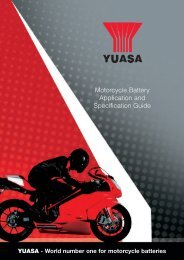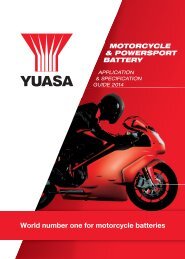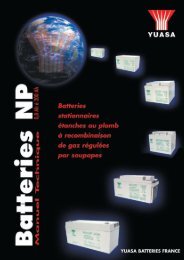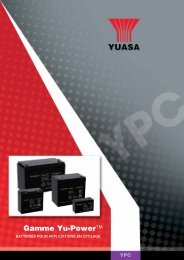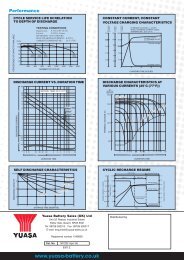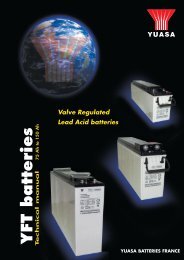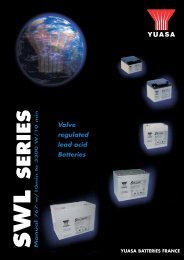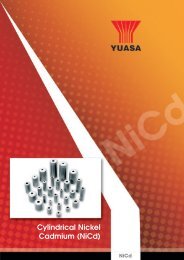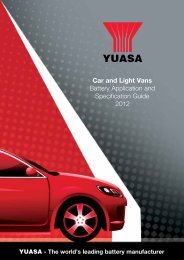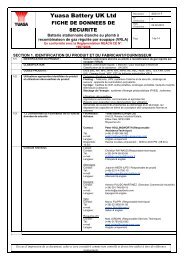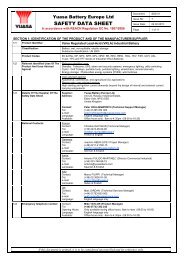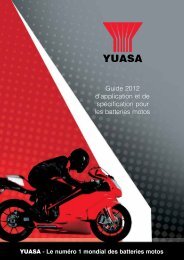YUASA - The world's leading battery manufacturer
YUASA - The world's leading battery manufacturer
YUASA - The world's leading battery manufacturer
Create successful ePaper yourself
Turn your PDF publications into a flip-book with our unique Google optimized e-Paper software.
AGM Explained<br />
Yuasa Automotive AGM<br />
• Improved active mass efficiency, through better<br />
absorption of the acid<br />
• Increased lifespan due to minimal active material<br />
shedding due to <strong>battery</strong> design<br />
• Higher cold start values<br />
• Totally Maintenance Free – zero water<br />
consumption<br />
• Spill proof/leak proof<br />
• Designed to meet latest OEM vehicle demands<br />
• Compatible with sensitive electronic equipment<br />
• AGM technology now factory fitted to numerous<br />
luxury cars and “Stop – Start” vehicle where<br />
increased AGM <strong>battery</strong> features are required<br />
Yuasa’s world <strong>leading</strong> motorcycle and industrial AGM<br />
(absorbent glass mat) technology comes to the automotive<br />
market. <strong>The</strong> Yuasa automotive AGM <strong>battery</strong> has been<br />
engineered to meet the growing extreme power demands of<br />
recently introduced vehicles now starting to enter the<br />
European aftermarket. Yuasa’s automotive AGM experience<br />
comes from vehicles such as the Mazda MX5 and the famous<br />
Toyota Prius and has now been launched for European vehicle<br />
<strong>battery</strong> designs.<br />
<strong>The</strong> new Yuasa AGM European 096 and 019 sized batteries<br />
provide reliable starting whilst coping with the extreme power<br />
needs of the modern vehicle. Laboratory evaluation is boasting<br />
4-5 times the cyclic durability of standard conventional flooded<br />
product and typically 16% higher starting power, even at lower<br />
temperatures. Increased reaction surface area ensures<br />
increased energy densities for faster engine rotation during<br />
starting and therefore maximising fuel efficiency.<br />
<strong>The</strong> AGM batteries utilises the same absorbent glass mat<br />
technology as used in Yuasa Motorcycle and Industrial<br />
batteries which have been on the market for over 44 years<br />
(1965). This absorbent glass mat absorbs the <strong>battery</strong>’s acid,<br />
enabling a more efficient use of the cell’s volume without the<br />
need for electrolyte reservoirs, as needed with conventional<br />
flooded batteries. <strong>The</strong> absorbent glass mat gives a number of<br />
key benefits to the design of the lead acid <strong>battery</strong>;-<br />
Within normal operating conditions, the use of the individual<br />
cell valve design and glass mat plate separation ensures<br />
gas recombination occurs and ensures that no water is<br />
lost therefore negating the need for electrolyte reservoirs<br />
and freeing the user from maintenance.<br />
• One way venting system providing partial pressure in<br />
each cell ensuring 100% leak proof and safe handling.<br />
• <strong>The</strong> acid absorption of the glass mat means that the<br />
<strong>battery</strong> packs can be operated under higher pressures<br />
than conventional flooded batteries this has benefits<br />
including significantly prolonging <strong>battery</strong> cycle durability<br />
by minimising paste shedding.<br />
• <strong>The</strong> increased pack pressures of the AGM <strong>battery</strong><br />
increase the batteries resistance to vibration.<br />
• More reaction surface area ensuring higher starting<br />
capacity within the same footprint as conventional<br />
flooded batteries.<br />
Frequently Asked questions<br />
Q. What are the differences between flooded and AGM<br />
Lead Acid batteries?<br />
A. See above, AGM batteries are built using a glass mat<br />
separator which enable all the electrolyte required by the<br />
<strong>battery</strong> to be stored within the glass mat, also allowing any<br />
gasses given off during charging to be recombined into<br />
water meaning that the batteries are totally maintenance<br />
free. <strong>The</strong> design benefits of the glass mat over<br />
conventional flooded batteries enable the <strong>battery</strong> pack to<br />
operate under higher pressure without the fear of<br />
insufficient electrolyte between the plates, <strong>leading</strong> to the<br />
step change in durability offered by AGM batteries over<br />
flooded. <strong>The</strong> quality of the glass mat is a critical item in<br />
ensuring the optimum life of the <strong>battery</strong> versus its<br />
application. This experience has been gained by Yuasa<br />
from over 44 years experience in the field using this<br />
technology. <strong>The</strong> automotive application <strong>battery</strong> designs<br />
are balanced with greater high rate starting performance<br />
and cycle life for the increased service/technological<br />
requirements of modern vehicle designs.<br />
Q. What are the differences between GEL and AGM<br />
(starved) batteries?<br />
A. Both are recombinant batteries (i.e. under normal<br />
operating conditions they recombine the gases given off<br />
during charging to form water) and both are classified as<br />
sealed valve regulated.<br />
<strong>The</strong> major difference is that in the AGM, the electrolyte is<br />
fully soaked into a special absorbed glass mat separator<br />
which immobilises the acid, whereas in the GEL batteries<br />
the acid is mixed with Silica to form a GEL also<br />
immobilising the acid. <strong>The</strong> benefits of AGM over GEL are<br />
that with the use of absorbed glass mat, the <strong>battery</strong> pack<br />
can be operated under a greater operating pressure so<br />
improving cyclic durability. With GEL, similar pack pressure<br />
can not be used so durability is usually provided by<br />
increased paste density which is good for life but not as<br />
good for high rate startability performance as required for<br />
automotive applications.<br />
Q. Why is charging voltage so critical to both GEL and<br />
AGM batteries?<br />
A. Charge voltage is critical with these types of batteries as<br />
both are recombinant batteries. This means that the<br />
oxygen that is normally produced on the positive plate in all<br />
lead acid batteries recombines with hydrogen given off by<br />
the negative plate. <strong>The</strong> recombination of the hydrogen and<br />
oxygen produces water, which recycles back to the <strong>battery</strong><br />
acid, therefore the <strong>battery</strong> is maintenance free and does<br />
not need topping up.<br />
<strong>The</strong> sealing vent used in the design ensures that a positive<br />
internal pressure is maintained to ensure the<br />
recombination of the gasses occur and not allow the cell to<br />
dry out and fail.<br />
Information<br />
<strong>YUASA</strong> - <strong>The</strong> <strong>world's</strong> <strong>leading</strong> <strong>battery</strong> <strong>manufacturer</strong><br />
195




